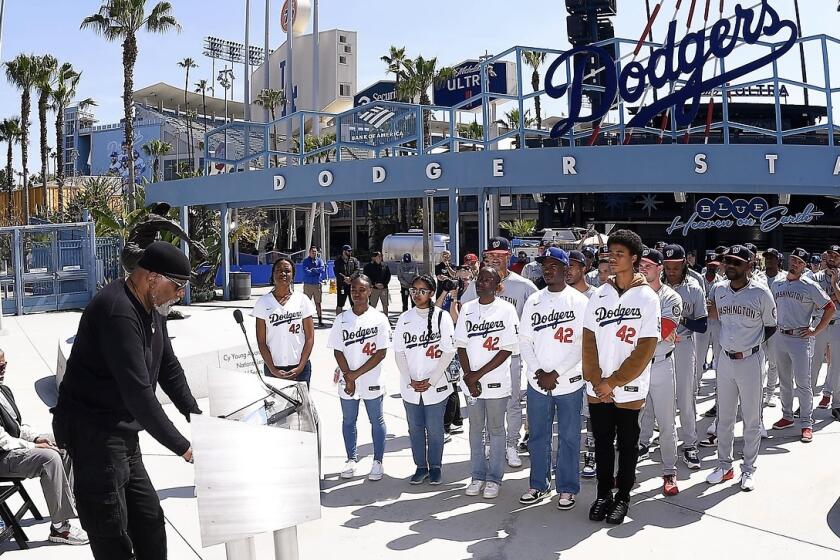Major League Baseball’s schedule reflects a maddening mapping
The Angels and Minnesota Twins played a three-game series this week in Minneapolis over a span of four days. And there wasn’t a rainout.
The games were scheduled on Monday, Wednesday and Thursday for what might be called weather insurance; for teams located east of the Rocky Mountains, Major League Baseball tries to build in off days after home openers just in case the first game is postponed because of rain.
That insurance date is just one square in the Rubik’s Cube that is MLB’s annual schedule, a mosaic of dates and locations spelling out where each of the sport’s 30 teams plays its 162 games — 81 at home and 81 on the road.
Building the schedule is a months-long endeavor involving several people, special computer software, input from the teams and television, compliance with MLB and players’ union travel rules, a bit of horse-trading among the clubs and, in the end, the teams’ acceptance that they can’t get every date they want where they want it.
“Everybody at some point will have a gripe or two about the schedule,” said Tim Mead, the Angels’ vice president of communications, who works on the team’s schedule with MLB. “But it’s a very daunting task to accommodate everybody.”
Katy Feeney, the MLB senior vice president who coordinates the task, calls it “a balancing act.”
Changing just one game at the request of one team can “have a ripple effect, and you may improve things for the one club but worsen things for another,” she said.
Baseball contracts with the Sports Scheduling Group, a Butler, Pa., firm that provides the computer skills that consider all the variables and delivers constantly refined drafts of the schedule.
“The biggest challenge is that the thing is just so big,” said Doug Bureman, the company’s coordinating partner. “There’s just so much going on here in terms of the number of teams, the number of games.”
And that’s just sorting out the dates. On the final schedule, the game times are set by the team or a television partner.
The process starts with Feeney’s sending a questionnaire to each club more than a year in advance, asking if they have special requests. They often do.
The Dodgers want to be home April 15, Jackie Robinson Day. The Boston Red Sox want to be home Patriots’ Day, the third Monday in April. The Toronto Blue Jays like playing at home July 1, Canada Day. Every team — especially the Washington Nationals — wants a home game on July 4.
There’s a flip side too: “We try to stay away from Mother’s Day [at home]; that’s a bad day for us” in terms of attendance, said Billy Hunter, the Dodgers’ vice president of ticket operations. “Labor Day is the same way.”
A team might also request a trip because its stadium is being used for a concert or some other purpose, or a facility near its stadium has an event that crowds hotel-room space and parking.
The Angels wanted to travel during a span in June 2010 because the rock group U2 planned concerts at Angel Stadium. The concerts eventually were postponed a year, to last June, so the Angels again sought to be on the road at that time.
Otherwise, teams want to keep travel to a minimum. “We prefer not to do a three-city East Coast trip to start the season,” Mead said.
Rules in the MLB’s labor contract with the players’ union also must be followed. “You can only play 20 consecutive days and then you have to have an off day,” Feeney said. Also, when a team is traveling from the Pacific time zone to the Eastern time zone, there has to be an off day for travel.
Among the other variables fed into the computers: Teams must play a requisite number of games against division foes (most play 18) and interleague games (15 to 18).
MLB annually tries to rotate the divisions in interleague play, but it doesn’t always work out that way. For example, the Dodgers have never been to Yankee Stadium since interleague play began in 1997.
All of this gets even more jumbled in 2013 when MLB realigns, with the Houston Astros moving to the American League and both leagues having 15 teams. (Currently there are 16 in the NL, 14 in the AL.) Interleague games will then be spread through the season instead of being bunched together around midseason as they are now.
Feeney and her group are currently working on that 2013 schedule, and have found it to be quite a challenge. “We’re still struggling with the format,” she said.
But even with same-league play, MLB builds in variety because “you don’t want the exact same schedule every year,” Feeney said.
And in markets with two teams, such as the Dodgers and Angels, “we try as much as possible to have one team home while the other team is on the road,” Bureman said.
After MLB gets its first drafts of the schedule, typically in the spring, they’re sent to a committee consisting of club personnel from each division. Panel members then look it over and suggest changes.
Then a revised schedule is sent to all the clubs — ideally by June — and finally to the players’ union and the TV carriers for their input. If all goes according to plan, next season’s schedule should be done by September.
Bureman, whose company also does the scheduling for several major-college conferences, summed up the job this way:
“We’re kind of in the business of seeking perfection, knowing that you’re never going to get there.”
More to Read
Get our high school sports newsletter
Prep Rally is devoted to the SoCal high school sports experience, bringing you scores, stories and a behind-the-scenes look at what makes prep sports so popular.
You may occasionally receive promotional content from the Los Angeles Times.






